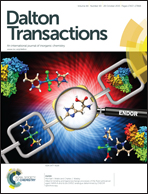The synergy between Ti species and g-C3N4 by doping and hybridization for the enhancement of photocatalytic H2 evolution
Abstract
A Ti species modified g-C3N4 photocatalyst was synthesized via an in situ hydrothermal route and the subsequent low-temperature calcination. The hydrothermal process results in not only the fabrication of TiO2/g-C3N4 heterojunctions, but also the coordination between Ti species and g-C3N4, which are verified by X-ray diffraction (XRD) and X-ray photoelectron spectroscopy (XPS). The electrical resistance test confirms that the coordination can improve the electrical conductivity of composites and can make the charge transfer easier. The photoluminescence (PL) and photocurrent measurements exhibit that the hybridization enhances the separation efficiency of photo-induced electrons and holes. As a result, the Ti species modified g-C3N4 photocatalysts exhibit much higher photocatalytic H2 evolution than the simple heterojunction of TiO2/g-C3N4 obtained via a microwave method and the mechanical mixture of TiO2 and g-C3N4 under visible-light irradiation. The coordination mechanism and synthesis route of TiO2/g-C3N4 heterojunctions are proposed.


 Please wait while we load your content...
Please wait while we load your content...